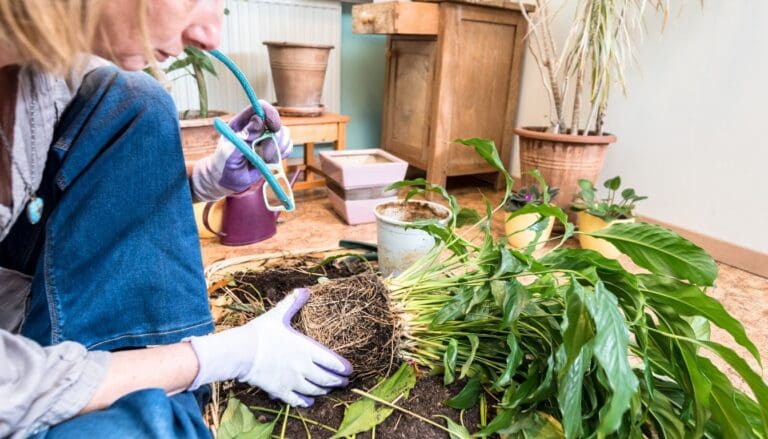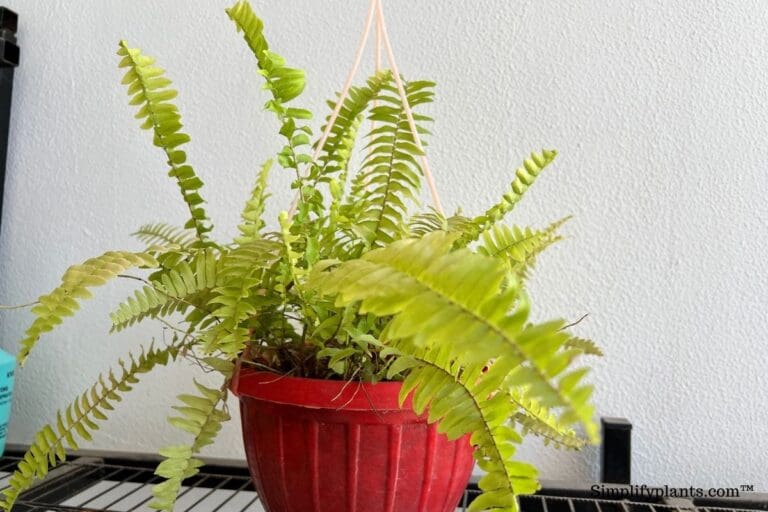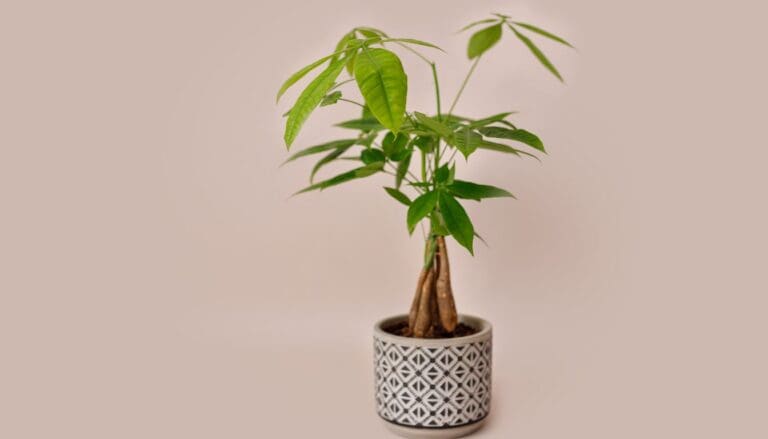Do String Of Pearls Attract Bugs? (Common bugs+How To Get Rid Of Them)
The string of pearls plant can tolerate some neglect in terms of living conditions, but it is not easy to deal with pests. Pests can be very harmful to your string of pearls. But does string of pearls attract pests? What kind of pests infests them, and how to deal with them? Let’s find out!
Aphids, mites, whiteflies, gnats, mealybugs, and ants are some common bugs attracted to the string of pearls. Avoid overwatering, mist the plant with neem oil solution, move the plant to a well-ventilated area, and look out for pests regularly to keep your string of pearls pest-free.
Using the appropriate treatment at the right time can help you get rid of the pests and make your plant healthy again. Keep reading this article to find out more about the pests and how to get rid of them.

Please note: Simplify Plants is reader-supported. Some links in the post are affiliate links and I get a commission from purchases made through links in the post.
Common pests on string of pearls
Some common bugs that can infest the string of pearls are:
- Mealybugs
- Aphids
- Scales
- Spider mites
- Whiteflies
- Fungus gnats
- Ants
Mealybugs

Mealybugs feed on the juices of your string of pearls and make it weak.
If you notice some white fluff or cotton-like substance on your string of pearls plant, you might want to check the underside of the leaves where these bugs usually hide.
The mealybugs are tiny bugs that are around 2-3 millimeters long. These are light brown or gray.
Mealybugs expel a substance that invites mold and creates an environment ideal for the spread of fungal and bacterial infections.
It is essential to isolate the plant as these bugs can spread quickly to other plants.
Aphids

Aphids infest the plant’s tissues and feed on them. It causes stunted growth and disfigured leaves on the string of pearls.
Aphids are little, fat bugs found in a wide range of colors. The most common ones are green in color.
You can spot the aphids on the leaves or flowers, and are found in large numbers on the plant.
Aphids secrete a sugary substance that promotes the growth of mold in the plant and attracts ants as well.
Scales

The scales feed on the sap and damage the plant, making them weak and vulnerable to diseases.
Scales are found in varying shapes, colors, and sizes as there are many species of scales.
You know scales have infested your string of pearls when you notice small brown spots on the plant.
Spider mites

Spider mites are deadly and can kill the plant as they can go unnoticed for a long time.
The sign that spider mites infest your string of pearls is that the plant starts losing its color and can even turn white.
If you notice small web-like structures and small brown spots on your string of pearls plant, you know spider mites have infested the plant.
Keep a check on the nearby plants other than your string of pearls to identify these bugs at an early stage before they do any severe damage.
The most commonly found spider mites are red, and they suck the sap of the plant along with the nutrients.
Whiteflies

Whiteflies are white and small insects that can grow large in number within a short time.
Whiteflies fly from the undersides of the leaves. Whiteflies secrete a substance that encourages the growth of mold.
Like most other bugs, the whiteflies suck the plant’s sap and leads to yellow leaves and stunted growth.
Fungus gnats

Overwatering and keeping the soil most for too long can attract fungus gnats to your string of pearls.
Fungus gnats are small flies that also resemble mosquitoes and are not as harmful as the other pests.
The larvae of the fungus gnats can be a problem as they chew the roots of the plants other than feeding on the organic matter in the soil.
Ants
You can find ants everywhere, including your string of pearls.
If you notice many ants on your plant, the chances are that the plant is infested with other bugs such as mealybugs or aphids.
These pests secrete a sugary substance that attracts ants to your plant.
Why does my string of pearls have bugs?
Major reasons behind pest infestation on the string of pearls can be:
- Overwatering
- Poor drainage system
- High humidity
- Lack of aeration
- Low light
Overwatering

The string of pearls doesn’t require a lot of water like many other plants. It doesn’t like to sit on water for long and doesn’t enjoy wet soil.
When you overwater the plant, the soil remains moist for a long time, inviting pests. Pests thrive in damp and humid environments.
Not giving sufficient time for the soil to dry out leads to an overwatered plant, so you should always check the soil’s moisture before watering.
You can fix a watering schedule to avoid giving the plant too much water and water only when required. Make sure you check the soil before watering. Only water when the soil feels a little dry.
Also read: How often should I water my string of pearls?
Poor drainage system
Other than overwatering, having an ineffective drainage system can also attract bugs to your string of pearls.
Using well-draining soil is a must for the string of pearls plant. Such soil will not retain too much water and will help the soil get dry fast.
Ensure that your pot has working drainage holes that let the extra water drain out after you have watered your string of pearls.
Along with a proper watering regime, well-draining soil and drainage holes in the pot are necessary to maintain a sound drainage system.
Also read: What kind of soil do string of pearls need?
High humidity

The string of pearls plant needs an average humidity level of 40-50%, and high humidity can be harmful to the string of pearls.
Keeping a check on the humidity level would be ideal as you will know when to take action if the humidity goes down.
When the string of pearls plant stays in high humidity for a long time, the leaves start yellowing, and it creates an environment that is ideal for the pests.
Lack of aeration
The string of pearls needs soil that allows air to flow between the roots so that the roots remain healthy. They also need good airflow around them to thrive.
Lack of aeration can lead to root rot that will attract pests. It will also not allow the soil to dry quickly, and such a situation can lead to bacterial or fungal growth other than a pest infestation.
Low light

The string of pearls enjoys six to eight hours of bright and indirect light. Keeping the plant in low light conditions for too long can bring diseases and pests.
If the plant doesn’t get sufficient light, the soil will remain moist for longer, leading to root rot. Root rot will invite pests that will make the plant weaker.
You can use artificial lights if your house doesn’t have a natural source of light.
Also read: How much light do string of pearls need?
How to get rid of bugs on the string of pearls?
There are different ways to treat the string of pearls and control pest infestation on them.
You can use organic miticides and chemical pesticides to get rid of bugs on your string of pearls.
Let’s check out the steps with which you can get rid of pests.
- If you notice that pests have infested your string of pearls, consider isolating them to stop the spread of the pests to the other plants.
- Disinfect the area where you placed the plant.
- Use sterilized pruners to prune the damaged leaves and areas infested by the insects.
- Place the plant under running water to get rid of as many bugs as possible.
- Spray the plant with plant-based miticides or use a pesticide that doesn’t contain harmful chemicals.
Plant-based miticides
Choosing a plant-based miticide will not harm the plant in any way and also get rid of the pests.
We have mentioned some options, and you can choose any one of these.
- Neem oil: You can use Neem oil to get rid of all sorts of bugs. You need to spray neem oil regularly to get rid of bugs. You can even use it to prevent bugs from infesting the plant.
- Cinnamate: This pesticide causes no harm to the plant and eliminates all stages of pest infestation. It is derived from cinnamon oil. You can spray this every three days for few weeks to remove the pests.
- Rosemary oil: Rosemary oil is harmless for both plants and humans. You can mix rosemary oil with water and spray the plant with it.
- Pyrethrum: The pyrethrum damages the nervous system of the pests and kills them. It is derived from a relative of chrysanthemum.
Use household chemicals
If nothing else is available near you, you can use the following ingredients to start the treatment as soon as you notice pests.
- Dish soap: Take 1 tsp of liquid dish soap and mix it with 1/4 gallons of water. Pour it into a bottle and spray the plant with this mixture. Do this regularly to see results.
- Rubbing alcohol: Mix rubbing alcohol with water in a 1:1 ratio and spray it on your plant. It is an effective way of getting rid of pests.
Use herbal tea as miticide
You can make herbal tea out of these ingredients.
- 1 tbsp cinnamon
- 1 tbsp cloves
Add these to a quarter of water and boil it. Add crushed garlic after cooling the mixture.
Strain the tea. Add a dash of dish soap to it. Pour the mixture into a bottle and spray it on the plant to get rid of the pests.
Tips to prevent bugs on string of pearls
- Spray neem oil on the plant even when it doesn’t have pest infestation as this will prevent the pests.
- Avoid overwatering the string of pearls as overwatering make the plant vulnerable to problems.
- Avoid misting the plant as it will increase the humidity level, and pests thrive in humid environments.
- Keep your string of pearls in a spot where it gets sufficient light and good aeration.
Sources: Common insect pests and diseases.
Recommended Garden Supplies
| Product Image | Our Recommended Gardening Supplies | Check Offers! |
|---|---|---|
Top Top
Top
Top
Top
Top
Top
Top
Top | rePotme Houseplant and Tropical Classic Potting Soil Mix | Check Offer On Amazon |
 Top
Top
Top
Top
Top
Top
Top
Top | Espoma Organic Indoor Plant Food | Check Offer On Amazon |
 Top
Top
Top
Top
Top
Top
Top
Top | GooingTop LED Grow Light 6000K Full Spectrum Clip Plant Growing Lamp | Check Offer On Amazon |
 Top
Top
Top
Top
Top
Top
Top
Top | Soil Moisture Meter | Check Offer On Amazon |
 Top
Top
Top
Top
Top
Top
Top
Top | Govee Hygrometer Thermometer, Bluetooth Enabled! | Check Offer On Amazon |
 Top
Top | LEVOIT Humidifiers for Large Room(Best For Plants) | Check Offer On Amazon |
 Top
Top
Top
Top
Top
Top
Top
Top | Upgraded DIY Automatic Drip Irrigation Kit, 15 Potted Houseplants Support | Check Offer On Amazon |
 Top
Top
Top
Top
Top
Top
Top
Top | Stainless Steel Heavy Duty Gardening Tool Set | Check Offer On Amazon |
 Top
Top
Top
Top
Top
Top
Top
Top | Bonide Insecticidal Soap | Check Offer On Amazon |
 Top
Top
Top
Top
Top
Top
Top
Top | Bonide 32 oz Spray Neem Oil for Organic Gardening | Check Offer On Amazon |
 Top
Top
Top
Top
Top
Top
Top
Top | Garden Safe Fungicide | Check Offer On Amazon |







